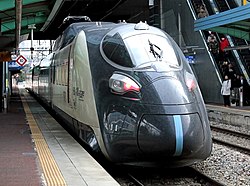HEMU-430X
| HEMU-430X | |
|---|---|

HEMU-430X passing through Seodaejeon Station.
|
|
| Manufacturer | Hyundai Rotem |
| Family name | Hanvit |
| Constructed | 2010-11 |
| Entered service | 2011 |
| Number built | 1 |
| Number in service | 0 |
| Formation |
TC+4M+MC
|
| Operator(s) | Korail |
| Depot(s) | Osong |
| Line(s) served |
Gyeongbu High Speed Railway Honam High Speed Railway |
| Specifications | |
| Car body construction | aluminum, composite |
| Train length | 147.4 m (484 ft) |
| Car length |
end cars: 23.5 m (77.1 ft) intermediate cars: 25.1 m (82 ft) |
| Width | 3,100 mm (122.0 in) |
| Height | 3,720 mm (146.5 in) |
| Maximum speed |
planned in tests/design: 430 km/h (267 mph) planned in service (KTX-III): 350–370 km/h (217–230 mph) |
| Weight | axle load: max. 14 t (15.4 short tons; 13.8 long tons) |
| Traction system | 18 three-phase asynchronous induction motors and permanent magnet synchronous motors IGBT-based VVVF inverters |
| Power output | 20 x 410 kW (550 hp) (8.2 MW or 11,000 hp) |
| Acceleration |
0.5 m/s2 (1.8 km/(h·s)) up to 150 km/h (93 mph)
|
| Power supply | 25 kV/60 Hz AC |
| Electric system(s) | catenary |
| Current collection method |
pantograph (type: single-bar) |
| UIC classification | 2'2' + Bo'Bo' + Bo'Bo' + Bo'Bo' + Bo'Bo' + Bo'Bo' |
| Braking system(s) | Eddy current, regenerative, rheostatic, disc |
| Safety system(s) | TVM 430, ATP, ATC |
| Multiple working | Yes |
| Track gauge | 1,435 mm (4 ft 8 1⁄2 in) standard gauge |
TC+4M+MC
0.5 m/s2 (1.8 km/(h·s)) up to 150 km/h (93 mph)
0 to...
HEMU-430X (standing for High-Speed Electric Multiple Unit 430 km/h eXperimental) is a South Korean high-speed train intended for a maximum speed of 430 km/h (267 mph). On the last day of March 2013, it achieved 421.4 km/h in a test run, making South Korea the world's fourth country after France, Japan and China to develop a high-speed train running on conventional rail above 420 km/h. The main new feature of the train compared to older South Korean high-speed trains is distributed traction. The foreseen commercial version of the train, tentatively named KTX-III, would enter regular service in 2015 with a top speed of 370 km/h (230 mph).
The original 1991 plan for the Korea Train Express (KTX) high-speed rail system foresaw an operating speed of 350 km/h (217 mph) to enable a travel time under two hours between Seoul in the northwest and Busan in the southeast of South Korea, the terminuses of the first line. Later, planned top speed was reduced to the 300 km/h (186 mph) maximum of existing high-speed trains on the market. Korail then ordered high-speed trains on the basis of Alstom's TGV Réseau, the KTX-I, which started KTX service on April 1, 2004, and operate at a top speed increased slightly to 305 km/h (190 mph) in November 2007.
In a project South Korean government research institutes and rail industry companies launched in 1996 to fully localise high-speed rail technology, the know-how gained in the technology transfer for the KTX-I was used as the basis to develop the experimental train HSR-350x, which was to be tested at up to 385 km/h (239 mph) so that the commercial version can have a top speed of 350 km/h (217 mph). However, the maximum speed achieved in the HSR-350x tests was 352.4 km/h (219.0 mph) on December 16, 2004; and the design and top speeds of the commercial version, the KTX-II (KTX-Sancheon) were set to be the same as those for the KTX-I.
The aim to develop commercial trains with a top speed of 350 km/h (217 mph) was taken up again in the project to build another experimental train, the HEMU-400X (High-speed Electric Multiple Unit - 400 km/h eXperiment), which was launched in July 2007. The six-year project schedule was originally set to last until July 2013, and involved 100,000 km (62,000 mi) of test runs with speeds reaching 400 km/h (249 mph). The project is led by the Korean Railroad Research Institute (KRRI) and Hyundai Rotem, and also involves the Korea Institute of Construction & Transportation Evaluation and Planning (KICTEP), 20 other companies, 13 universities, and one other organisation. The project budget was set at 97.11 billion won, with a government contribution of 69.2 billion won.
...
Wikipedia
